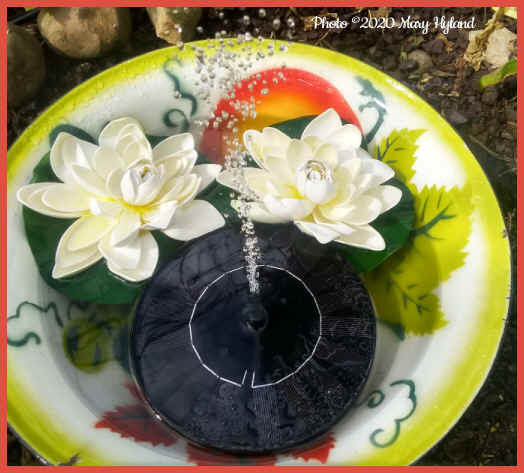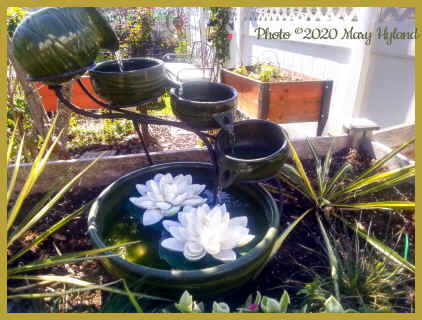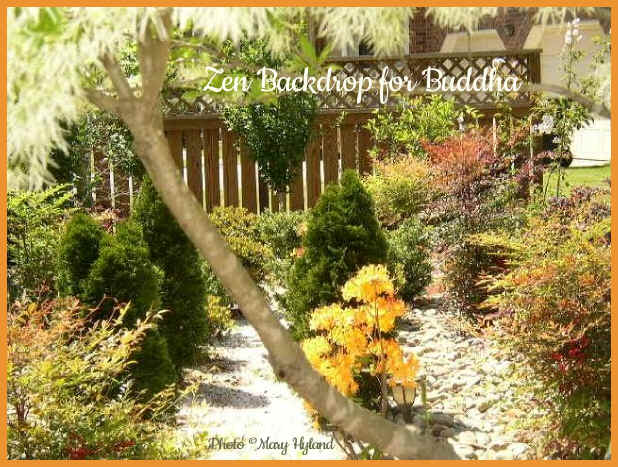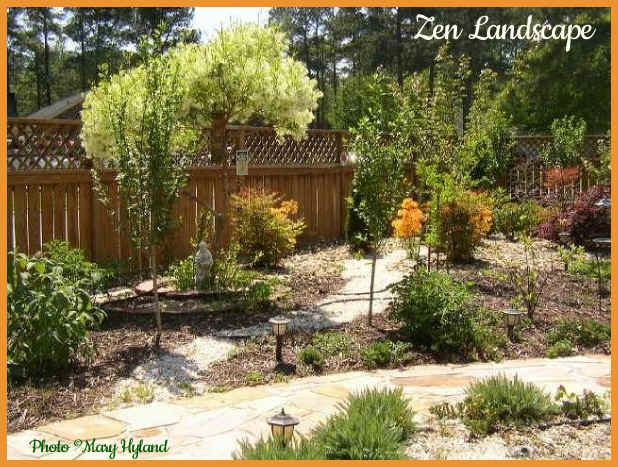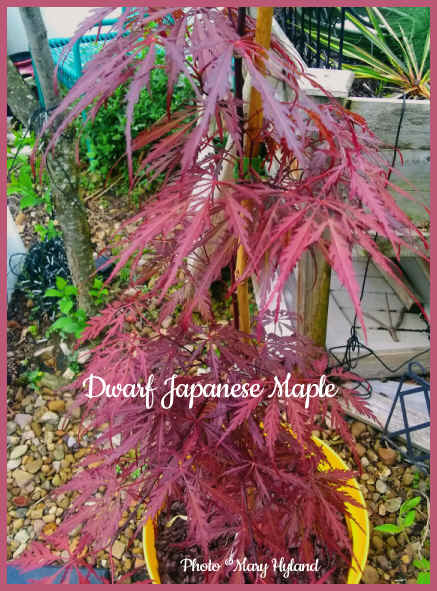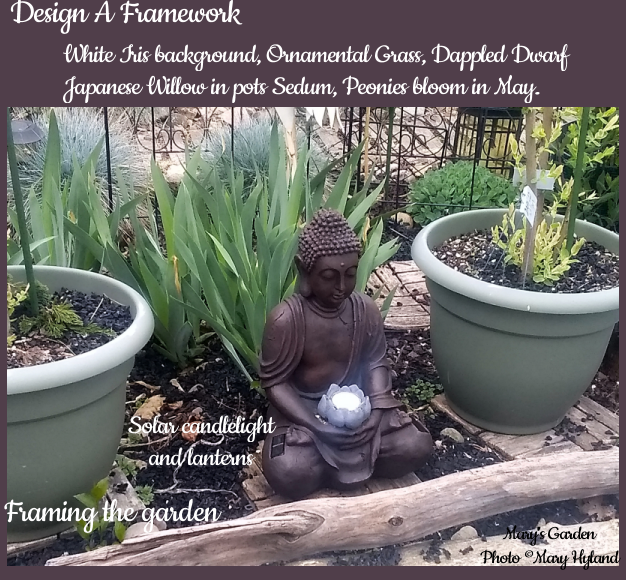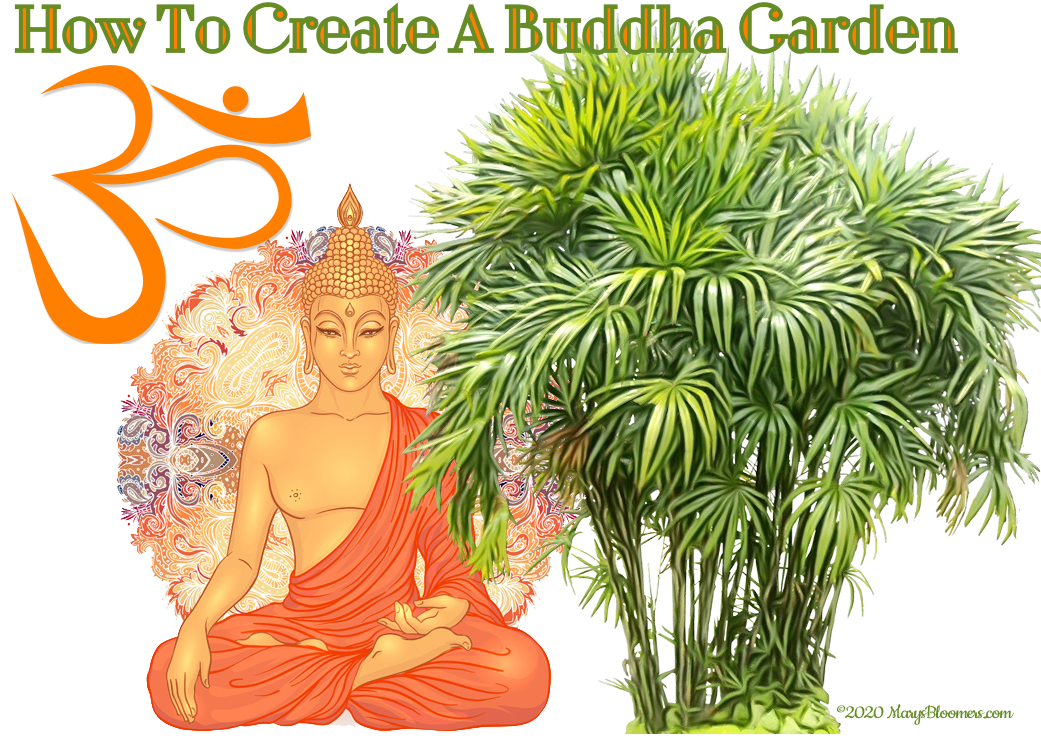 If you have a gazebo or pergola, it would be easy to just design within and around that space, starting with placement of your Buddhas, if you're starting from scratch. If there's an existing planting or shrubs there, place your Buddhas and plant the accents amid and around those. |
| The Buddha Garden
This garden can be designed in a landscape as either a full-sized garden or as a very pretty miniature garden within a larger and similar one. It can be used as a section or part of zen, serenity, yoga, Chinese, Japanese or Sants Garden. The Buddha Garden is similar to, but not considered a religious "Buddhist" garden, which incorporates historic sacred plants, herbs and decor to create the sacred space. The Buddha garden concentrates on the attributes of The Buddha, along with herbs and plants as decor within the serenity space. Many types of Buddha would be displayed, and not all of them are Buddhist representations. The Buddha Garden would be dedicated to attributes of Buddha - in the multi-ethnic sense. Buddhist, Hindu, etc. and within that, Indian, Tibetan, Chinese, Japanese and other Asian cultural representations. The design possibilities are endless, the zen and serenity will be apparent, and the plants and colors will be perfect for use in meditation and Tea Gardens. Similar zen ideas using different concepts. I like the style because you can mix all Asian styles and symbolism to tie in with the Buddhas of differing ethnicities. And this is why a Buddha Garden is exceptionally awesome.
To me, a Buddha Garden is a natural garden design subject, and quiet forests are the design clue. A Buddhist Garden would be much more intricate and a lot of cosmic or religious thought must go into your design. Buddha spent most of his time in gardens, and received enlightenment beneath the Bodhi Tree. Buddhist monks have stunningly beautiful and serene monastery gardens, in which to meditate and grow their food and healing herbs. This is a sacred space in several ways, and not all of it is steeped in religion. Your space is sacred to you, alone. You may want to relax, reflect, meditate, pray, practice Yoga, talk to your plants, grow medicinal herbs. You may want it to contain a little tea garden area. Or you may just want to visit for the sights and sounds within that ground you after a trying day or experience. I like to visit my gardens at night, so ornamentation for evening sits are a must for me. You don't want to make it look or feel like a commercial spa..... but you do want to feel Physicall and psychologically pampered. For a more spa-like experience, design a Yoga Garden in a nook or secluded area of the garden. Keep the garden's main focus on Buddha and the sacred, not on activity. Think (Asian), simple plantings, clean and geometric shapes, movement, sound (rustling leaves, fountains), color and fragrance. A little minimalism will go a long way in your Buddha garden. Keep the focus on him/her. Use bold shapes in plants and choose some plants with interesting or contorted limbs that also bear fruit or flowers. Choose dwarf ornamentals that can be potted and mobile. You can change your garden frequently, and plants will be easier to tend. Dwarf fruit trees will fruit earlier than standards, with the same size fruits. If you have already designed a Hindu or Serenity Garden in your landscape, it's very easy to design a Buddha Garden as an extension of that, and just use the plants you have and add a few others. The ornaments you used in a Hindu Garden design work perfectly within or around a Buddha Garden. If you're starting from scratch, here's the information on how to do that. It's entirely possible to have a Hindu and Buddhist Garden design that complements and adds to each other. Most of the steps are done if you already have either one of these gardens. Other sacred symbolism that is important to you can be used, and Buddha can reside happily with sculptures and symbols of other ethnicities and religions. It's about "Oneness", and not about "onlyness". Nothing sacred to you should be excluded. Buddhas are the main subject and most of your sculptures should be Buddha, but others can be scattered around the garden and placed among the flowers.
What you'll need for the
basics of the Buddha Garden design Decorative flower beds and planters, pathways made from stone, gravel, brick or wood, and features created with pebbles or sand. Driftwood or petrified wood accents here and there within the beds. Bamboo is a must. There are very beautiful non-running (clumping) varieties you can plant into the ground. I prefer beautiful stone-look, bamboo design, or clay pots for a p0rtable design. This also allows me to move the plants around according to my whim-of-the-week, and to bring some indoors for winter. Bamboo is excellent as a houseplant. Bring one indoors, along with one of your Buddha sculptures, add one of your Jade Trees and some lotus sculptures and candles, and you made your winter zen. The Buddhas Solar Lighting and Solar
fountains
My favorite fountains are the cascading pottery pitcher and bowls types. I use floating solar fountains (these come with several different water spray attachments) in my birdbaths. The birds love it for splashing, bathing and drinking, and the sounds of all of these working together making differing subtle water sounds is soothing and welcoming. I place a floating fountain in my large, antique enamelware bowls and float a faux waterlily and pad in it. My next acquisition will be the fountains made from hollow bamboo stems that you place over the edges of pails and bowls for spilling.
Chimes, hanging bells, rain
chains |
| Candles/solar
lanterns and lights These are a must on tables, set upon stones, placed around or on Buddha sculptures, and on pathways. Floating candles can go into the birdbaths and water features. Warm white solar string lights are beautiful wound around shrubs and trees. Symbols - Buddhist, Hindu and Asian symbols and decor look beautiful around a Buddha. On fences, poked into the ground, handing from branches. Om symbols, mandalas and lotus-shaped metal wall hangings can also go everywhere. Float realistic-looking foam waterlilies in your chosen water features. Pond suppliers carry these. Seating for relaxation or
meditation Bird and Butterfly Sanctuaries Include several bird baths and feeders. If you are going to add a water feature keep this in mind: if you will be adding bowl of water with floating fountains, you still have to be aware that depth is important - I've rescued or removed baby birds from a few until i understood that once they're wet, they cannot immediately take flight, and if your bowl is not shallow or made of slick materials, they cannot get out once they go in to drink or splash around. Place a few heavy stones inside the water feature, so that they can cling to something and climb out. Or at least dry off. I learned this the sad way. Birdbaths are designed to be the right depth for birds. Try to keep the depth at that level or less in a homemade water feature or pond. Choose and space ornamental fencing and trellises so that small birds can't get caught within or between them. Nothing is more beautiful and joyful than the sound of birdsong. I find it most prevalent early mornings and early evenings, after they dine. Note: Caution About Predators - eliminate anything that is a danger to the birds you are enticing to your garden. You don't want to lead them to torturous deaths. The bird's worst and most cruel enemy is the cat. They will cruelly torture birds, then either rip them apart, decapitate them, or leave the carcasses for you to clean up. Keep your cats confined, and rid your gardens of the neighbor's or feral cats using deterrants and animal control authorities. You can trap them in humane catch-and-release methods and return them to the owner, but you are wasting your time, because most roaming cats have owners who will not confine their cats. Shelters won't take them, either, if you know who the cat belongs to. My best deterrant is my dog, and she loves birds. But cats will wait and hunt when she's not outside. My second best deterrant is my broom. Putting a bell on a cat is useless, especially in a habitat that also includes chimes and bells. The birds eventually ignore the normal garden sounds. Another predator to watch out for is the hawk. If these frequent your area, you want to chase them off. They can harm or kill small pets, as well as birds. Create a simple butterfly garden within the habitat. Contrary to popular belief, in the 10 years my birds and butterflies have made my garden their home, i have never seen a bird chase or eat one. A proper habitat for both means that birds will eat all bug pests and the food you provide, and they will leave other things alone. The birds in my garden are well-fed, and they don't eat any of my fruits and berries, either. Growing milkweed in pots will provide everything the Monarch Butterfly needs for survival of the species. If you are as lucky as I have been, you might have tagged Monarchs visiting who are migrating to Mexico and are being tracked. The Design and The Plants
I envision peaceful and clean spaces, or lush forest atmospheres for Buddha Gardens. Hardscaping is an important part. Rocks, gravel, wood. Achieving this atmosphere is easy, because the range of flowering, foliage, and fruiting plants you can use is almost endless. Focus on potted and "mobile" plants that can be brought indoors for winter, if needed, or to move some blooming plants into an area that is not in bloom. It's easy to find or create balance and grow many more plants by growing in attractive pots, and it is easier to care for them. You can combine in-ground shrubs or a centerpiece tree and use pots in clusters around them. My perfect combination in serenity garden plantings would be a Hindu/Buddhist/Japanese Garden flower, fruit and foliage landscape. But the name is too long. I combine elements from all of them. Perfect in a garden spotlighting The Buddha from several cultures. It's easy to design it, because so many styles and decor fit in. Start with your idea of Zen, then build around that. - Choose several Buddhas and
ground-level sculptures symbolizing peace, prayer and goodness. Choose a
variety of Hindu, Buddhist, and Thai representations. Vining flower and foliage plants are a treat for the eyes, and flowering vines will attract birds and pollinators... those hard-working garden visitors who pollinate my garden daily and provide me with more and better flowers, vegetables and fruit all season. Vines require pruning and training to keep them in the size and shape you want. Growing them in pots with trellises in or behind them is a way to do that easily. And more varieties of vines can be grown. My honeysuckle and trumpet vine is grown on tall, ornate, metal trellises and wind around the trellises and metal fence panels that match. Honeysuckle is also trained to vine around an ugly back gate and chain link fence. Hummingbirds are frequentl flyers around the trumpet-shaped blooms of honeysuckle and the Hummingbird Mint i place around the garden in big planters bring the visitors a little lower down visually in the plantings. Honeysuckle is trained onto the top of my ornamental white picket fence in front of the house - tied onto stakes or fence panels with plant tape or ties. It can and should be used everywhere, even if only for the scent. They should be grown in pots. Certain honeysuckles can get out of control quickly and take over a garden if not confined to large pots. That's how i grow mine. After a little bit of training, they quickly go up and around where i tied them to, and then they fill in gaps. I keep them pruned because they grow fast and quickly scramble up structures in their path. You can't see the pots on mine once the vine matures. So i don't use expensive ornamental pots, i use pots as functional items. Honeysuckle flowers all summer and the foliage is very attractive, too. It doesn't need much maintenance except for occasional trimming or training. There are many varieties combining the oranges, deep reds, yellows and whites that coordinate very well with the design. Feathery ferns and ivies can be planted just about anywhere to frame your garden. Foliage plants can be chosen that blend well with others - palms, bamboo and ornamental grasses all feel right at home together and add depth and texture to the garden. Fig tree leaves are stunning and dwarf fig trees add a symbolic, biblical and tropical feel to the area. And let's not forget that sweet and healthy fruit. Some varieties of fig bear fruit twice a year. And most are self-pollinating. There are varieties whose trunks and branches grow in interesting curves and shapes. These can be planted in-ground, if the variety is hardy in your planting zone, or brought inside for winter dormancy in an unheated basement, garage or shed. They can also make beautiful houseplants if brought inside before going dormant. You can have an easy to grow zen garden indoors and outdoors. Here are a few more of my favorites
suggested for zen and Asian Gardens that will look awesome in your
Buddha Garden design. Suggested
Plants
Plants and Dwarf Trees -
Lots to choose from Decor Visiting your Buddha Garden will be a phisical and soul-soothing experience if it is planned well. If you plant or place something that doesn't make you happy or turns out to be more maintenance than you'd like, eliminate it. Nothing should be out of place or upset your inner harmony. Set up a pretty table in a spot with your favorite teapot and china cup, and treat yourself to your favorite herbal teas. Listen to the birdsong and take in the fragrances. Don't forget to take a trip there on warm summer evenings when the Jasmines and Honeysuckles emit their best fragrances, and your fairy lights and lanterns work their magic. If you are growing herbs in the garden, early evening and early morning are the best times to snip some for your kitchen. Whether you meditate in this space or just unwind surrounded by Nature and her sounds, serenity will be easy to achieve.
Authentic Japanese Gardens ---> Prayer Gardens---> Chakra Gardens---> Spiral Gardens---> Hindu Gardens---> Dedicated Mary Gardens----> Biblical Gardens---> Saints Gardens---> Native American Medicine Wheel---> |
Content, graphics,
photos and design ©2020 marysbloomers.com™
All rights reserved.



